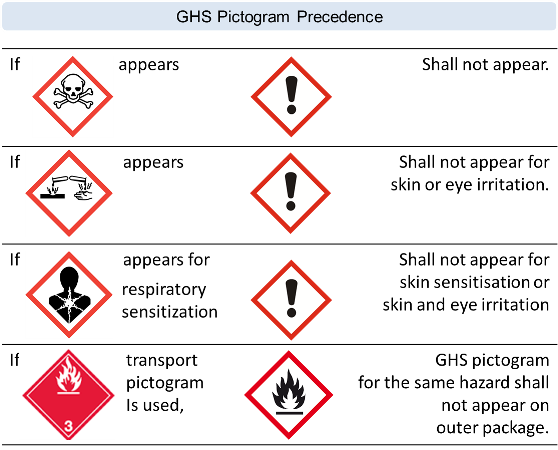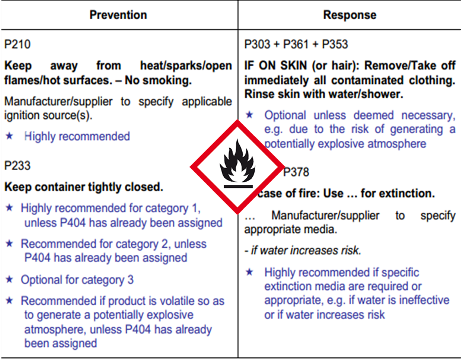GHS Precedence Rules for Pictogram, Signal Word and Hazard Statement
Little Pro on 2016-01-06
For a hazardous chemical classified with multiple hazards, it is very important that we use prioritized GHS pictogram, signal word or hazard statements to communicate the most significant hazards first. In this article, we have summarized main GHS precedence rules for pictogram, signal word, hazard statement and precautionary statements. We hope that you find this article helpful.
Precedence Rules for GHS Pictograms
For health hazards: Exclamation mark should not appear if:
- if skull and crossbones applies; or ;
- if used for skin sensitization or skin/eye irritation;
- If corrosive pictogram applies; or
- If the health hazard pictogram appears for respiratory sensitization.
The picture below summarizes GHS pictogram precedence.

Precedence for Signal Words
If "Danger" is used, "warning" should not appear. Only one of them needs to appear on a label.
Precedence Rules for Hazard Statement
All hazard statements should appear on a GHS label, except those as specified below:
- If H410 "Very toxic to aquatic life with long lasting effects" is assigned, H400 "Very toxic to aquatic life" may be omitted;
- If H411 "Toxic to aquatic life with long lasting effects" is assigned, H401 "Toxic to aquatic life" may be omitted;
- If H412 "Harmful to aquatic life with long lasting effects" is assigned, H402 "Harmful to aquatic life" may be omitted;
- If H314 "Causes severe skin burns and eye damage" is assigned, H318 "Causes serious eye damage" may be omitted;
Even though different competent authorities may decide whether to use above precedence rules or not, most of countries have adopted above rules when implementing GHS.
Precedence Rules for Precautionary Statement
There is no standard precedence rule for precautionary statements in UN GHS. You may include all precautionary statements on a GHS label (code is unnecessary). However, many competent authorities (EU, Korea, and Australia) have limited the number of precautionary statements on a label to make a label more readable. In this case, you have to learn how to select the most relevant precautionary statements on a label. This is particularly important if you are preparing a label for a chemical classified with multiple hazards or if you wish to save some space on a label.
ECHA's guidance on classification and labelling has classified all precautionary statements into four categories: highly recommended, recommended, and optional and not to be used. Normally you can include highly recommended or recommended ones.
The picture below shows how precautionary statements are categorized for a flammable liquid in ECHA's guidance. If you wish to read more, please click the picture to download the guidance.
Where a chemical is classified for a number of hazards, and the precautionary statements are similar, the most stringent shall be included on the label (this will be applicable mainly to preventive measures). An order of precedence may be imposed by the chemical manufacturer, importer or responsible party in situations where phrases concern "Response." Rapid action may be crucial. For example, if a chemical is carcinogenic and acutely toxic, rapid action may be crucial, and first aid measures for acute toxicity will take precedence over those for long-term effects. In addition, medical attention to delayed health effects may be required in cases of incidental exposure, even if not associated with immediate symptoms of intoxication.
Reference & Resources
- Introduction to GHS by the United Nations;
- Introduction to UN GHS;
- ECHA's Guidance on Chemical Classification and Labelling.
Having Questions?
We do not provide consultancy services. If you have questions or need any help, please contact our sponsor. You may also find an expert in CSP business directory below. If you are a consultant, you may get yourself listed in CSP business directory (free) or sponsor this page to leave your contact info on this page..

Tags: Topics - GHS, GHS Basics and Tutorials
